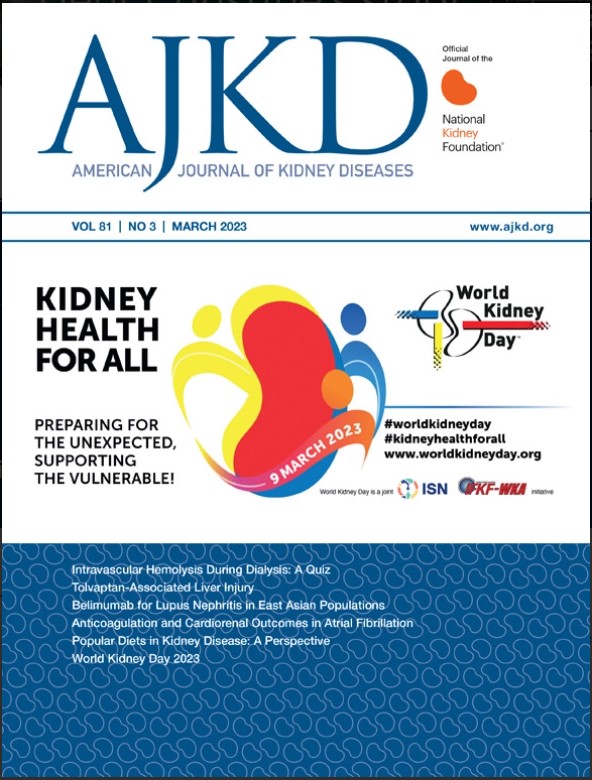肾脏替代疗法对环境的影响:一项比较生命周期评估。
IF 8.2
1区 医学
Q1 UROLOGY & NEPHROLOGY
引用次数: 0
摘要
理由与目的医疗服务的提供与大量温室气体(GHG)和其他污染物的排放有关。虽然肾脏替代疗法(KRTs)的相对健康和经济影响已经被研究过,但它们对环境的相对影响却没有得到很好的描述。本研究试图通过比较不同类型的KRT来描述这些影响。研究设计:比较生命周期评估(LCA)。地点和参与者数据收集在不列颠哥伦比亚省温哥华的温哥华总医院实施。三种KRTs:已故供体肾移植(KT)、自动/循环腹膜透析(PD)或中心血液透析(HD)。结果:使用世界配方(H) 2016方法评估KRTs一年以上的环境影响。分析方法生命周期清单结果被转化为3个端点和18个中间点的环境影响类别,包括气候变化、空气污染、人类毒性和水资源枯竭。结果:在大多数环境影响类别中,包括气候变化、空气污染、人类毒性和水资源枯竭,HD的环境影响最大,KT的环境影响最小。接受HD的患者对气候的影响分别比接受KT和PD的患者高74%和46%。同样,HD占总空气污染影响的65%,人类毒性的54%,水资源消耗的44%。PD对水分消耗(41%)和金属消耗(81%)的影响最大。除陆地生态毒性外,KT的影响在所有类别中均最低。在每项治疗中,患者和工作人员的旅行和消耗品是温室气体排放的最大贡献者。由于缺乏公开数据,制药被排除在本研究之外。结论kt是最环保的KRT。PD对环境的影响小于HD。了解KRTs的相对环境影响有助于为肾衰竭管理的临床决策提供信息。本文章由计算机程序翻译,如有差异,请以英文原文为准。
Environmental Impacts of Kidney Replacement Therapies: A Comparative Lifecycle Assessment.
RATIONALE & OBJECTIVE
Healthcare delivery is associated with considerable greenhouse gas (GHG) and other pollutant emissions. Although the relative health and economic impacts of kidney replacement therapies (KRTs) have been examined, their comparative environmental impacts have been poorly described. This study sought to characterize these impacts, comparing across types of KRT.
STUDY DESIGN
A comparative lifecycle assessment (LCA).
SETTING & PARTICIPANTS
Data collection implemented at Vancouver General Hospital in Vancouver, British Columbia.
EXPOSURE
Three KRTs: deceased donor kidney transplant (KT), automated/cycler peritoneal dialysis (PD), or in-center hemodialysis (HD) OUTCOME: Environmental impacts of KRTs over one year were evaluated using the World ReCiPe (H) 2016 method.
ANALYTICAL APPROACH
Lifecycle inventory results were transformed into three endpoints and 18 midpoint environmental impact categories including climate change, air pollution, human toxicity, and water depletion RESULTS: Across the majority of environmental impact categories, including climate change, air pollution, human toxicity, and water depletion, HD had the highest environmental impact and KT the lowest. The climate impact from a patient receiving HD was 74% and 46% more than from patients receiving KT and PD, respectively. Similarly, HD accounted for 65% of total air pollution impacts, 54% of human toxicity, and 44% of water depletion. The highest impact of PD was on water depletion (41%) and metal depletion (81%). KT demonstrated the lowest impact across all categories except terrestrial ecotoxicity. Within each therapy, patient and staff travel and consumables were the largest contributors to GHG emissions.
LIMITATIONS
Pharmaceuticals were excluded from this study due to a lack of publicly available data.
CONCLUSION
KT is the most environmentally preferred KRT. PD had fewer environmental impacts than HD. Understanding the relative environmental impacts of KRTs can help inform clinical decision-making in the management of kidney failure.
求助全文
通过发布文献求助,成功后即可免费获取论文全文。
去求助
来源期刊

American Journal of Kidney Diseases
医学-泌尿学与肾脏学
CiteScore
20.40
自引率
2.30%
发文量
732
审稿时长
3-8 weeks
期刊介绍:
The American Journal of Kidney Diseases (AJKD), the National Kidney Foundation's official journal, is globally recognized for its leadership in clinical nephrology content. Monthly, AJKD publishes original investigations on kidney diseases, hypertension, dialysis therapies, and kidney transplantation. Rigorous peer-review, statistical scrutiny, and a structured format characterize the publication process. Each issue includes case reports unveiling new diseases and potential therapeutic strategies.
 求助内容:
求助内容: 应助结果提醒方式:
应助结果提醒方式:


